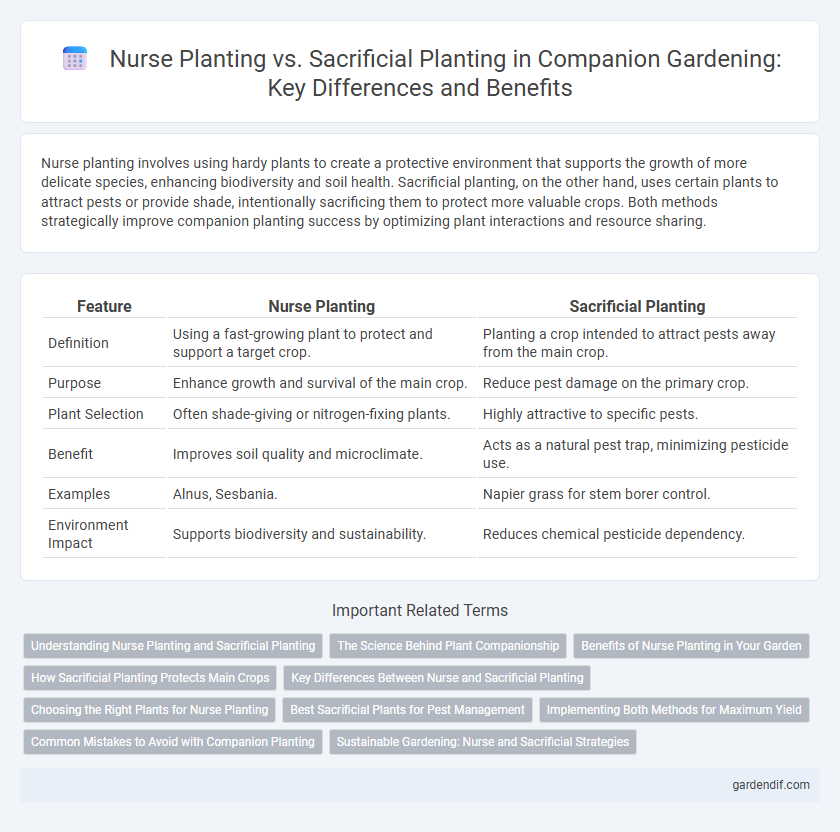
Nurse planting vs sacrificial planting Illustration
Nurse planting involves using hardy plants to create a protective environment that supports the growth of more delicate species, enhancing biodiversity and soil health. Sacrificial planting, on the other hand, uses certain plants to attract pests or provide shade, intentionally sacrificing them to protect more valuable crops. Both methods strategically improve companion planting success by optimizing plant interactions and resource sharing.
Table of Comparison
| Feature | Nurse Planting | Sacrificial Planting |
|---|---|---|
| Definition | Using a fast-growing plant to protect and support a target crop. | Planting a crop intended to attract pests away from the main crop. |
| Purpose | Enhance growth and survival of the main crop. | Reduce pest damage on the primary crop. |
| Plant Selection | Often shade-giving or nitrogen-fixing plants. | Highly attractive to specific pests. |
| Benefit | Improves soil quality and microclimate. | Acts as a natural pest trap, minimizing pesticide use. |
| Examples | Alnus, Sesbania. | Napier grass for stem borer control. |
| Environment Impact | Supports biodiversity and sustainability. | Reduces chemical pesticide dependency. |
Understanding Nurse Planting and Sacrificial Planting
Nurse planting involves using hardy plants to provide shelter and improved growing conditions for more sensitive species, enhancing biodiversity and plant survival rates. Sacrificial planting, in contrast, uses specific plants to attract pests or absorb environmental stressors, protecting valuable crops from damage. Understanding these strategies is essential for optimizing plant health and yield in sustainable agriculture and ecological restoration.
The Science Behind Plant Companionship
Nurse planting leverages established plants to create microclimates that protect seedlings from harsh environmental stresses, enhancing survival rates through shade and moisture retention. Sacrificial planting involves using less valuable plants to attract pests away from main crops, reducing damage and minimizing chemical inputs. Scientific studies reveal that these companion planting strategies optimize resource use and improve ecosystem resilience, leading to sustainable agricultural practices.
Benefits of Nurse Planting in Your Garden
Nurse planting enhances garden biodiversity by providing young plants with essential shade, moisture retention, and protection from harsh weather conditions, leading to higher survival rates and healthier growth. This method reduces the need for chemical inputs by fostering natural pest control through diverse plant interactions and attracting beneficial insects. Its sustainable benefits include improved soil fertility and structure, which contribute to long-term garden resilience and productivity.
How Sacrificial Planting Protects Main Crops
Sacrificial planting involves growing specific crops that attract pests away from the main crops, effectively reducing pest pressure and preventing damage to valuable plants. This method creates a protective barrier, allowing the primary crops to thrive without significant pest interference. By strategically placing sacrificial plants, farmers enhance crop resilience and reduce the need for chemical pest control.
Key Differences Between Nurse and Sacrificial Planting
Nurse planting involves using hardy plants to create a protective environment that enhances the growth and survival of more sensitive species by providing shade, moisture retention, and wind protection. Sacrificial planting, on the other hand, entails planting species that are intentionally allowed to suffer or be removed to benefit the main crop, often by attracting pests or providing nutrients through biomass. The key differences lie in nurse plants fostering growth through environmental support, whereas sacrificial plants act as protective buffers or nutrient sources at the expense of their own health.
Choosing the Right Plants for Nurse Planting
Selecting the right plants for nurse planting involves prioritizing species that provide shade, moisture retention, and soil enrichment, such as legumes or fast-growing shrubs. These plants should have strong root systems that stabilize the soil without outcompeting the primary crops for nutrients. Emphasizing native or well-adapted species ensures better ecosystem compatibility and enhanced survival rates in nurse planting strategies.
Best Sacrificial Plants for Pest Management
Sacrificial planting uses specific plants like nasturtiums, marigolds, and radishes to attract pests away from valuable crops, effectively reducing pest damage. These plants act as natural decoys, luring aphids, whiteflies, and flea beetles, which improves overall garden health without chemical intervention. Selecting the right sacrificial plant tailored to local pest species enhances pest management efficiency in companion planting systems.
Implementing Both Methods for Maximum Yield
Combining nurse planting with sacrificial planting enhances crop resilience by leveraging nurse plants to provide shade and nutrients while sacrificial plants attract pests away from main crops. This integrated companion planting strategy boosts overall yield by reducing pest damage and improving soil health. Farmers implementing both methods can optimize resource use and achieve sustainable, high-yield harvests.
Common Mistakes to Avoid with Companion Planting
Common mistakes in nurse planting versus sacrificial planting include misidentifying plant roles, which can lead to ineffective protection or nutrient competition. Failing to consider plant compatibility and spacing often results in reduced growth or increased pest issues. Proper selection based on species traits and environmental needs is crucial to optimize companion planting benefits.
Sustainable Gardening: Nurse and Sacrificial Strategies
Nurse planting enhances sustainable gardening by supporting young plants with protective neighbors that improve soil health, retain moisture, and shield from harsh weather, leading to higher survival rates and better growth. Sacrificial planting involves using certain plants to attract pests away from valuable crops, reducing the need for chemical pesticides and promoting ecological balance. Both strategies optimize resource use, increase biodiversity, and contribute to resilient, eco-friendly garden ecosystems.
Nurse planting vs sacrificial planting Infographic

 gardendif.com
gardendif.com